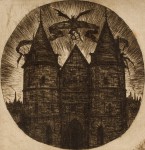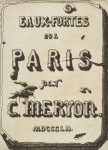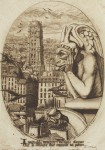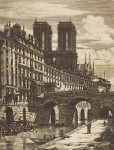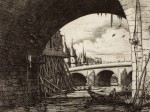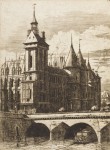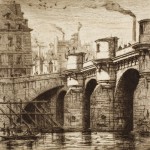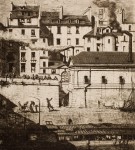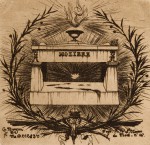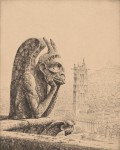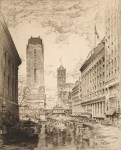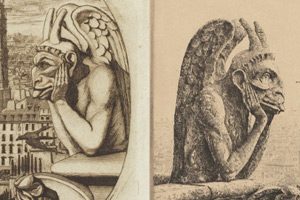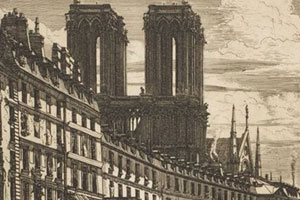This exhibition brings together the work of Charles Meryon and John Taylor Arms, printmakers who revered the art and architecture of medieval Europe.
Meryon, a champion of the Etching Revival in France, became renowned for Etchings of Paris (Eaux-fortes sur Paris) (1850-54), a series depicting the city’s medieval buildings and streets during a period of grand-scale urban renovation. Meryon’s views of the Ile de la Cité and bridges stretching across the Seine often include fantastical and macabre details: gargoyles perched on Notre-Dame, flocks of menacing birds, and historic monuments looming over minutely-drawn figures, alive and dead. Meryon produced prints in multiple states, meticulously altering their composition and tone—even as his mental state sharply and tragically declined.
Charles Meryon Architectural Etchings
In the early 20th century, American printmaker John Taylor Arms praised Meryon’s series as “a monument unique in its sensitive, imaginative, and deeply spiritual expression of architectural form and meaning”—his 1923 etching The Thinker (Le Penseur) reinterprets Meryon’s iconic grotesque subject. Trained as an architect, Arms found artistic inspiration in Europe’s diverse and regionally distinctive architectural styles, especially enduring Gothic structures encountered during his extensive travels. In the United States, the Gothic Revival skyscrapers of New York City fascinated him. This exhibition presents Arms’s views of Paris, Venice, Stockholm, New York, and beyond–including the recent VMFA acquisition An American Cathedral (The Woolworth Building)—all of which he rendered with laborious precision.
John Taylor Arms Architectural Etchings
Remnants and Revivals celebrates the technical prowess of these leading etchers whose varied lines capture the glory of the Gothic and its architectural nuances: hard, exact incisions give form to Manhattan skyscrapers; ragged, expressive drypoint scratches lend texture to ancient, porous limestone; and fine, undulating grooves enhance rivers with a surface that reflects the cities, old and new, through which they flow. Selections for this exhibition highlight both artists’ devotion to craftsmanship by the range of colored papers and inks represented and that each of the impressions from Meryon’s Etchings of Paris is a rare, unpublished artist’s proof.
Cocurated by Kristie Couser, Curatorial Assistant for the Mellon Collections, and Christopher Oliver, Assistant Curator of American Art, this exhibition is largely drawn from the Frank Raysor Collection, a generous, ongoing promised gift to the museum.
Image Credit:
The Vampire (Le Stryge), 1853, Charles Meryon (French, 1821—1868), etching in brown ink on laid paper, fourth of eight states.
Promised Gift of Frank Raysor
The Thinker of Notre-Dame (Le Penseur de Notre-Dame), 1923, John Taylor Arms (American, 1887–1953), etching on wove paper.
Bequest of John Barton Payne


